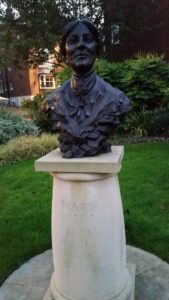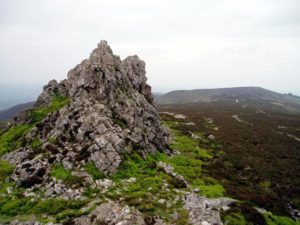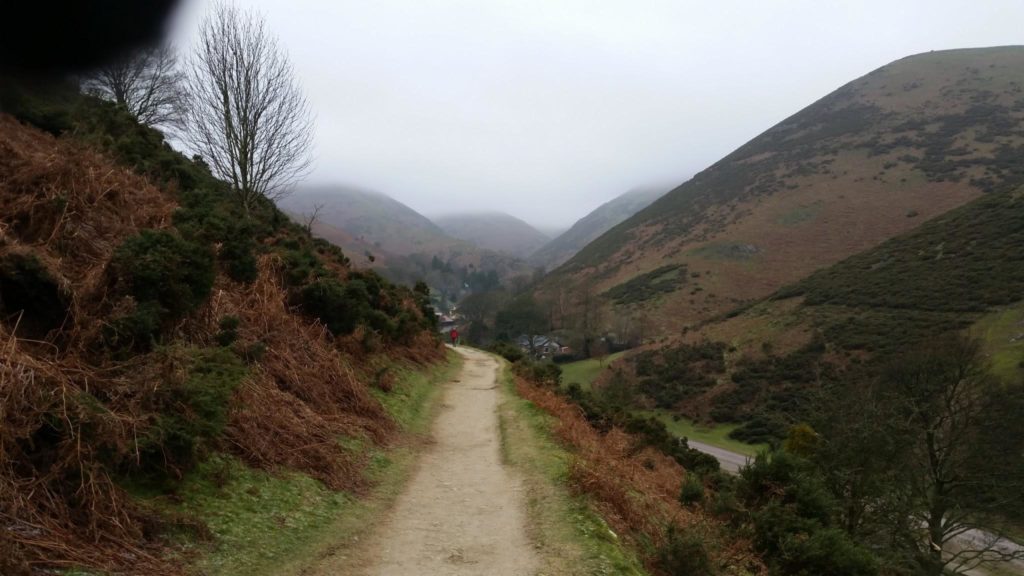In the Footsteps of… Mary Webb
Paul Jeorrett follows the trail of overlooked writer Mary Webb in the Shropshire countryside
I wonder how many of you have heard of Mary Webb? If you have, it will almost certainly be for her most famous book Precious Bane, or possibly the 1950 Powell and Pressburger film of Gone to Earth. Both are great places to begin if you have never come across her as an author, although the film is probably a little of its time, despite being filmed in her home county of Shropshire.
Mary Webb is certainly an author worth getting to know, especially as she has relatively local connections: she was born near Shrewsbury in 1881 and lived most of her forty-six years in and around Shrewsbury and the Shropshire Hills. Her biographer, Gladys Mary Coles, in her Dictionary of National Biography article on Webb, says she felt an affinity for Wales, her father’s native country, as well as the Shropshire Hills. She spent some periods of time away from Shropshire in London, Chester and Somerset, but always longed to return to her home county. Her short life was often a struggle and, throughout, she suffered with Graves’ disease, which was one of the eventual causes of her death in 1927.
 Next time you go to Shrewsbury, just outside the Library the statue of Charles Darwin has recently been joined by this bust of Mary Webb (l).
Next time you go to Shrewsbury, just outside the Library the statue of Charles Darwin has recently been joined by this bust of Mary Webb (l).
A contemporary of Thomas Hardy, she published six novels, as well as poetry, short stories and some nature writing. She was praised by John Buchan and Rebecca West, and posthumously promoted by the then prime minister Stanley Baldwin in his Royal Literary Fund speech in 1928. Probably the greatest praise came when Stella Gibbons parodied her writing in the 1932 novel Cold Comfort Farm.
So why is Thomas Hardy a fixture in the English literary canon, while few people have heard of, let alone read any, Mary Webb? Eloise Millar, in her 2009 Guardian blog ‘Mary Webb, brighter and better than Thomas Hardy’, asks: could it be about gender? Mary Webb certainly shares a lot of similarities with Hardy: her characters are passionately drawn from real life, mainly country dwelling and deeply embedded in and influenced by the landscape in which they live. In many ways she is at least as good a writer as, if not better than, Hardy, and I wonder how much better she might have become had she lived longer. Having said that, some of her poetry is a little twee for my taste, her language can be a little overblown and, as with Conan Doyle, there is a definite belief in fairies and elven folk; but that may just be because she was writing in the early twentieth century.
I first came across Mary Webb when my mother recommended Precious Bane as one of her favourite books. Reading it as a shy and often bullied teenager, I found that the challenges of the main character Prue Sarn, including a hare lip and difficult family circumstances, struck a chord with me. Unlike many of Hardy’s female characters, Webb’s Prue Sarn has real strength of character, finds joy in life and nature where she can and her steadfastness wins through in the end. It is truly a novel of the highest quality and should be better known. I devoured all of Webb’s other books, which were reprinted in the Virago Modern Classics series in the 1980s; I love the mostly uplifting plots, which are based in local landscape and folklore and have a real affinity for nature. If you have been listening to our recent Calon Talks Books shows, you will know that one of our preoccupations has been the magical realism and (sometimes) darkness of the British countryside, and how that landscape influences character and plot; we have seen this in books ranging from Susan Cooper’s The Dark is Rising sequence through to Sarah Perry’s The Essex Serpent.
Many years later, having moved to North Wales, I went for my first walk in the footsteps of Mary Webb, in the Shropshire Hills, at the Stiperstones, a quartzite outcrop near Snailbeach. This landscape appears in several of Webb’s novels, including The Golden Arrow and Gone to Earth. Right at the top of these hills is the Devil’s Chair: local legend has it that when it is shrouded in mist it conceals the Devil occupying his throne. This is a description from The Golden Arrow:
‘For miles around, in the plains, the valleys, the mountain dwellings it was feared. It drew the thunder, people said. Storms broke round it suddenly out of a clear sky; it seemed almost as if it created storm… It had the look of a chair from which the occupant has just risen, to which he will shortly return.’

The Devil’s Chair on the Stiperstones, Shropshire, England (r).
Photo by Blisco, 14 May 2006.
(Creative Commons Share Alike 3.0 licence)
The Shropshire Hills have justifiably earned their Area of Outstanding Natural Beauty status but, as my friend and I approached the top of the Stiperstones, the mist descended and the legend of the Devil’s Chair became all too real! I am glad to say we didn’t have any satanic encounters that day, but we felt we had been very close to the source of inspiration for Mary Webb.
More recently I ventured out from Church Stretton to do a very wintery circuit up Ragleth Hill, and from Little Stretton along Ashes Valley to the top of the Long Mynd, returning down Carding Mill Valley. This is definitely the heart of Mary Webb country: in fact, she spent her honeymoon in a cottage in the Ashes Valley, exploring the walks around the Long Mynd. When I went, it was deep winter with light snow on the ground and the waterfalls partly frozen into icicles. I barely saw anyone outside the town, and the landscape was very disorientating even though not far from civilisation. As I approached the top of the Long Mynd, the mist descended in a slightly threatening and atmospheric way again; my thoughts returned to my earlier trip to the Stiperstones, and I took the sensible, safe route back to Church Stretton. You can easily imagine Stella Gibbons’ character Aunt Ada saying, ‘…there’s something nasty in the woodshed.’ Maybe I have too vivid an imagination, having read too much fiction? The upside is that there is an excellent independent bookshop called Burway Books in Church Stretton, and lots of places for a warm, restorative drink!

Carding Mill Valley looking towards the mist shrouded Long Mynd, Shropshire
I hope this short piece will inspire you to seek out Mary Webb’s works, and then to put on your walking boots and go and experience her landscape. There are four Mary Webb Trails, not to mention plenty of information about Webb and her works on the Shropshire Tourism website.
I’ll leave you with this description of Mary Webb, from the poet Walter de la Mare’s introduction to her collected poems:
‘She brought her own quietness into a room – bright blue eyes, fair brown hair, small hands; bird-like, demure. She loved to listen to others talking quite as much as to talk to herself, but her own talk had an extraordinary eagerness and vivacity. Then her nervousness was no more, and she shared her own intense interest and her own happiness.’
But the last word should go to Mary Webb herself. This is one of her poems, appropriate for this dark time of year just as the light is returning:
In Dark Weather
Against the gaunt, brown-purple hill
The bright brown oak is wide and bare;
A pale-brown flock is feeding there-
……..Contented, still.
No bracken lights the bleak hill-side;
No leaves are on the branches wide;
No lambs across the fields have cried;
……..-Not yet.
But whorl by whorl the green fronds climb;
The ewes are patient till their time;
The warm buds swell beneath the rime –
……..For life does not forget.
© Paul Jeorrett 2018
